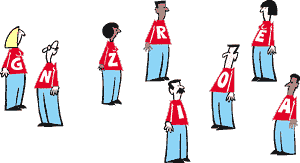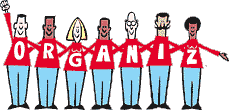Although every workplace is different and the needs of workers vary, there are some basic steps involved in winning a union voice on the job. Here's how it happens ...

To begin organizing a union at your workplace there’s a simple starting point before going through the steps listed below: quietly talk to a few of your co-workers who you think may be interested in organizing.

This small group starts to privately discuss workplace issues, what is involved in organizing a union, and making plans to contact UE. When you’re ready, contact us and a UE representative will meet with the small group to answer your questions and help you develop a comprehensive organizing plan.
Step 1: Build an Organizing Committee

Leaders are identified and an organizing committee representing all major departments and all shifts and reflecting the racial, ethnic and gender diversity in the workforce is established. Organizing committee training begins immediately. Committee members must be prepared to work hard to educate themselves and their co-workers about the union and to warn and educate co-workers about the impending management anti-union campaign. The organizing committee must be educated about workers’ right to organize and must understand UE policies and principles of democracy and rank-and-file control.
Also at this step basic information about the workplace must be gathered including:
- workplace structure: departments, work areas, jobs, shifts
- employee information: name, address, phone, shift, job title, and department for each worker (employee list)
- employer information: other locations, parent company, product(s), customers, union history
Step 2: Adopt An Issues Program

The committee develops a program of union demands (the improvements you are are organizing to achieve) and a strategy for the union election campaign. A plan for highlighting the issues program in the workplace is carried out through various organizing campaign activities.
Step 3: Sign-Up Majority on Union Cards

Your co-workers are asked to join UE and support the union program by signing membership cards. The goal is to sign-up a sizable majority. This "card campaign" should proceed quickly once begun and is necessary to hold a union election.
Step 4: Win the Union Election

The signed cards are used (and required) to petition the state or federal labor board to hold an election. It will take the labor board at least several weeks to determine who is eligible to vote and schedule the election. The union campaign must continue and intensify during the wait. If the union wins, the employer must recognize and bargain with the union. Winning a union election not only requires a strong, diverse organizing committee and a solid issues program, but there must also be a plan to fight the employer’s anti-union campaign.
Step 5: Negotiate a Contract

The organizing campaign does not let up after an election victory. The real goal of the campaign, a union contract (the document the union and the employer negotiate and sign, covering everything from wages to how disputes will be handled), is still to be achieved. Workers must be mobilized to support the union’s contract demands (decided by you and your co-workers) and pressure the employer to meet them.
Organized! Make It Your Union!

In UE, we are proud of our democratic tradition: UE members run their own local unions — and there's no other union where this is a truer statement. But you don't "go it alone," either. UE will be with you every step of the way — helping with everything from organizing to negotiating your first contract ... and helping you learn how to build and run your own local union.
Will we still be there after you win your first contract? Absolutely! While we want and encourage our locals to make their own decisions on issues of local importance, the resources of the national union will always be there when you need them — along with a staff person to provide guidance and support. To find out more about how UE works as the "USA's Rank-and-File Union", check out our "About UE" section and especially our on-line pamphlet, UE Aims and Structure.
